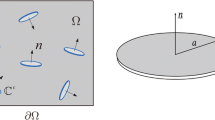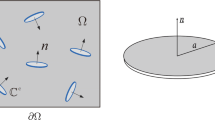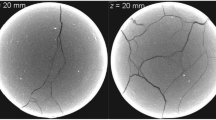Abstract
Triaxial compression tests are conducted on a quasi-brittle rock, limestone. The analyses show that elastoplastic deformation is coupled with damage. Based on the experimental investigation, a coupled elastoplastic damage model is developed within the framework of irreversible thermodynamics. The coupling effects between the plastic and damage dissipations are described by introducing an isotropic damage variable into the elastic stiffness and yield criterion. The novelty of the model is in the description of the thermodynamic force associated with damage, which is formulated as a state function of both elastic and plastic strain energies. The latter gives a full consideration on the comprehensive effects of plastic strain and stress changing processes in rock material on the development of damage. The damage criterion and potential are constructed to determine the onset and evolution of damage variable. The return mapping algorithms of the coupled model are deduced for three different inelastic corrections. Comparisons between test data and numerical simulations show that the coupled elastoplastic damage model is capable of describing the main mechanical behaviours of the quasi-brittle rock.








Similar content being viewed by others
Abbreviations
- σ 1 :
-
Major principal stress
- σ 3 :
-
Minor principal stress, confining pressure
- σ cc, σ ci, σ cd, σ p and σ r :
-
Characteristic stresses of crack closure, initiation, damage, peak strength and residual strength, respectively
- ɛ p1 :
-
Major principal plastic strain
- ɛ p3 :
-
Minor principal plastic strain
- E :
-
Damaged elastic modulus
- ω :
-
Damage variable
- \( {\varvec{\upsigma}} \) :
-
Stress tensor
- \( {\mathbf{S}} \) :
-
Deviatoric stress tensor
- \( {\kern 1pt} p \) :
-
Mean stress
- \( {\kern 1pt} q \) :
-
Deviatoric shear stress
- θ :
-
Lode’s angle
- J 3 :
-
The third invariant of the deviatoric stress tensor
- \( {\varvec{\upvarepsilon}} \) :
-
Strain tensor
- \( {\varvec{\upvarepsilon}}^{e} \) :
-
Elastic strain tensor
- \( {\varvec{\upvarepsilon}}^{p} \) :
-
Plastic strain tensor
- ϕ :
-
Thermodynamic potential
- ϕ e :
-
Elastic part of the thermodynamic potential
- ϕ p :
-
Plastic part of the thermodynamic potential
- \( \bar{\gamma }^{p} \) :
-
Internal plastic variable or equivalent plastic shear strain
- R :
-
Thermodynamic force associated with plasticity
- Y :
-
Thermodynamic force associated with damage
- Y e :
-
Elastic part of the thermodynamic force associated with damage
- Y p :
-
Plastic part of the thermodynamic force associated with damage
- λ p (dλ p):
-
Plastic multiplier (increment)
- λ ω (dλ ω):
-
Damage multiplier (increment)
- \( {\mathbf{e}}^{{{\kern 1pt} p}} \) (\( {\text{d}}{\mathbf{e}}^{{{\kern 1pt} p}} \)):
-
Plastic deviatoric strain tensor (increment)
- \( {\varvec{\updelta}} \) :
-
Kronecker tensor
- ɛ pv (dɛ pv ):
-
Plastic volumetric strain (increment)
- ɛ p m (dɛ p m ):
-
Mean plastic volumetric strain (increment)
- F p :
-
Plastic criterion
- G p :
-
Plastic potential
- F ω :
-
Damage criterion
- G ω :
-
Damage potential
- \( {\mathbf{D}} \) :
-
Elastic damage stiffness tensor
- \( {\mathbf{D}}_{0} \) :
-
Initial elastic stiffness tensor
- \( {\mathbf{D}}^{ep} \) :
-
Elastoplastic stiffness tensor
- \( {\mathbf{D}}^{e\omega } \) :
-
Elastodamage stiffness tensor
- \( {\mathbf{D}}^{ep\omega } \) :
-
Coupled elastoplastic damage stiffness tensor
- \( {\mathbf{D}}^{p\omega } \) and \( {\mathbf{D}}^{\omega p} \) :
-
Coupled plastic–damage stiffness tensor
- \( {\kern 1pt} \chi^{p\omega } \) :
-
A comprehensive function reflecting plastic hardening and damage softening effects on the evolution of yielding surface
- H p :
-
Plastic modulus
- H ω :
-
Damage modulus
- H pω and H ωp :
-
Coupled plastic–damage moduli
- e r :
-
Tiny value set for numerical computation
- E 0 and ν 0 :
-
Elastic parameters: representing initial elastic modulus and Poisson’s ratio, respectively
- α 1 and \( {\kern 1pt} \kappa \) :
-
Drucker–Prager strength parameters: representing internal friction and cohesion, respectively
- α 2 :
-
Parameter: representing shear–volumetric dilation
- h 0 and h 1 :
-
Plastic hardening parameters: representing initial and final yielding thresholds, respectively
- b :
-
Parameter: representing plastic hardening rate
- ω c :
-
Parameter: representing asymptotic damage at the residual deformation stage
- β :
-
Parameter: representing damage evolution rate
- r :
-
Weight coefficient
- a :
-
Parameter: representing damage softening
References
Cai M, Kaiser PK, Tasaka Y, Maejima T, Morioka H, Minami M (2004) Generalized crack initiation and crack damage stress thresholds of brittle rock masses near underground excavations. Int J Rock Mech Min Sci 41(5):833–847
Chang SH, Lee CI (2004) Estimation of cracking and damage mechanisms in rock under triaxial compression by moment tensor analysis of acoustic emission. Int J Rock Mech Min Sci 41(7):1069–1086
Chen L, Wang CP, Liu JF, Liu J, Wang J, Jia Y, Shao JF (2015) Damage and plastic deformation modeling of beishan granite under compressive stress conditions. Rock Mech Rock Eng 48(4):1623–1633
Chiarelli AS, Shao JF, Hoteit N (2003) Modeling of elastoplastic damage behavior of a claystone. Int J Plast 19(1):23–45
Conil N, Djeranmaigre I, Cabrillac R, Su K (2004) Thermodynamics modelling of plasticity and damage of argillite. CR Mec 332(10):841–848
Eberhardt E, Stead D, Stimpson B, Read RS (1998) Identifying crack initiation and propagation thresholds in brittle rock. Can Geotech J 35(2):222–233
Hayakawa K, Murakami S (1997) Thermodynamical modeling of elastic–plastic damage and experimental validation of damage potential. Int J Damage Mech 6(4):333–363
Horii H, Nemat-Nasser S (1985) Compression-induced microcrack growth in brittle solids: axial splitting and shear failure. J Geophys Res Atmos 90(NB4):3105–3125
Hu DW, Zhu QZ, Zhou H, Shao JF (2010) A discrete approach for anisotropic plasticity and damage in semi-brittle rocks. Comput Geotech 37(5):658–666
Huang J, Griffiths DV (2008) Observations on return mapping algorithms for piecewise linear yield criteria. Int J Geomech 8(4):253–265
Ju JW (1989) On energy-based coupled elastoplastic damage theories: constitutive modeling and computational aspects. Int J Solids Struct 25(89):803–833
Lemaitre J, Dufailly J (1987) Damage measurements. Eng Fract Mech 28(s5–6):643–661
Martin CD (1997) Seventeenth Canadian geotechnical colloquium: the effect of cohesion loss and stress path on brittle rock strength. Can Geotech J 34(5):698–725
Parisio F, Samat S, Laloui L (2015) Constitutive analysis of shale: a coupled damage plasticity approach. Int J Solids Struct 75–76:88–98
Pensée V, Kondo D, Dormieux L (2002) Micromechanical analysis of anisotropic damage in brittle materials. J Eng Mech 128(8):889–897
Qiu SL, Feng XT, Xiao JQ, Zhang CQ (2014) An experimental study on the pre-peak unloading damage evolution of marble. Rock Mech Rock Eng 47(2):401–419
Salari MR, Saeb S, Willam KJ, Patchet SJ, Carrasco RC (2004) A coupled elastoplastic damage model for geomaterials. Comput Methods Appl Mech Eng 193(27–29):2625–2643
Shao JF, Rudnicki JW (2000) A microcrack-based continuous damage model for brittle geomaterials. Mech Mater 32(10):607–619
Shao JF, Jia Y, Kondo D, Chiarelli AS (2006) A coupled elastoplastic damage model for semi-brittle materials and extension to unsaturated conditions. Mech Mater 38(3):218–232
Simo JC, Hughes TJR (1998) Computational inelasticity. Springer Science Business Media, LLC, New York
Tsang CF, Bernier F, Davies C (2005) Geohydromechanical processes in the excavation damaged zone in crystalline rock, rock salt, and indurated and plastic clays—in the context of radioactive waste disposal. Int J Rock Mech Min Sci 42(1):109–125
Wong TF (1982) Micromechanics of faulting in westerly granite. Int J Rock Mech Min Sci 19(2):49–64
Xie N, Zhu QZ, Xu LH, Shao JF (2011) A micromechanics-based elastoplastic damage model for quasi-brittle rocks. Comput Geotech 38:970–977
Yang SQ, Jing HW, Wang SY (2012) Experimental investigation on the strength, deformability, failure behavior and acoustic emission locations of red sandstone under triaxial compression. Rock Mech Rock Eng 45(4):583–606
Yang S-Q, Ranjith PG, Jing H-W, Tian W-L, Ju Y (2017) An experimental investigation on thermal damage and failure mechanical behavior of granite after exposure to different high temperature treatments. Geothermics 65(2):180–197
Zhang JC, Xu WY, Wang HL, Wang RB, Meng QX (2016a) Testing and modeling of the mechanical behavior of dolomite in the Wudongde hydropower plant. Geomech Geoeng 11(4):270–280
Zhang JC, Xu WY, Wang HL, Wang RB, Meng QX, Du SW (2016b) A coupled elastoplastic damage model for brittle rocks and its application in modelling underground excavation. Int J Rock Mech Min Sci 84:130–141
Zhao XG, Cai M, Wang J, Ma LK (2013) Damage stress and acoustic emission characteristics of the Beishan granite. Int J Rock Mech Min Sci 64(10):258–269
Zhou H, Zhang K, Feng XT (2011) A coupled elasto-plastic–damage mechanical model for marble. Sci China Technol Sci 54(S1):228–234
Zhou H, Bian HB, Jia Y, Shao JF (2013) Elastoplastic damage modeling the mechanical behavior of rock-like materials considering confining pressure dependency. Mech Res Commun 53(5):1–8
Zhu QZ, Shao JF (2015) A refined micromechanical damage–friction model with strength prediction for rock-like materials under compression. Int J Solids Struct 60–61:75–83
Zhu QZ, Kondo D, Shao JF (2008) Micromechanical analysis of coupling between anisotropic damage and friction in quasi brittle materials: role of the homogenization scheme. Int J Solids Struct 45(5):1385–1405
Acknowledgements
The work presented in this paper was financially supported by the National Natural Science Foundation of China (Grant No. 51609070).
Author information
Authors and Affiliations
Corresponding author
Rights and permissions
About this article
Cite this article
Zhang, JC. Experimental and Modelling Investigations of the Coupled Elastoplastic Damage of a Quasi-brittle Rock. Rock Mech Rock Eng 51, 465–478 (2018). https://doi.org/10.1007/s00603-017-1322-z
Received:
Accepted:
Published:
Issue Date:
DOI: https://doi.org/10.1007/s00603-017-1322-z




